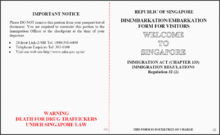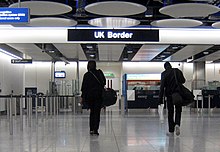Type a search term to find related articles by LIMS subject matter experts gathered from the most trusted and dynamic collaboration tools in the laboratory informatics industry.


An arrival card, also known as an incoming passenger card, landing card or disembarkation card, is a legal document used by immigration authorities of many countries to obtain information about an incoming passenger not provided by the passenger's passport (such as health, criminal record, where they will be staying, purpose of the visit, etc.) and to provide a record of a person's entry into the country.[1][2][3][4] The card may also provide information on health and character requirements for non-citizens entering the country.[5] Some countries require an arrival card for each incoming passenger, while others require one card per family unit, and some only require an arrival card for non-citizens only.
Some countries, such as Thailand, attach a departure card to the arrival card, which is retained in the alien's passport until their eventual departure. This arrival card can also be combined with a customs declaration, which some countries require incoming passengers to fill out separately.
The procedure of compiling information from physical immigration cards is no longer required by the authorities of Singapore (which switched to electronic cards)[6] and the United States following the introduction of the biometric recording system by the Immigration and Checkpoints Authority and the United States Customs and Border Protection respectively.[3][7] There is minimal cross-border formality between a number of countries, most notably those in the passport-free travel area of Europe's Schengen Area.[8]
The requirement to produce an arrival card is usually in addition to a requirement to produce a passport or other travel document, to obtain a visa, and sometimes complete a customs declaration.

The information requested varies by country. Typically, the type of information requested on the arrival card includes:
Travellers are generally required to sign, date, and declare the information is true, correct, and complete.
Some countries which have retired physical arrival cards, switched to requiring passengers to submit their arrival cards electronically, for example Singapore[6] and Malaysia.[9]

Non-EEA citizens were formerly required to complete a landing card on entry to the United Kingdom. The traveller was required to present the completed form at the Border Force desk at the point of entry. The form was usually supplied by the airline, train or ferry company.[10]
In the UK, the landing card system was governed by the Immigration Act 1971, schedule 2 paragraph 5, which states;[11]
The Secretary of State may by order made by statutory instrument make provision for requiring passengers disembarking or embarking in the United Kingdom, or any class of such passengers, to produce to an immigration officer, if so required, landing or embarkation cards in such form as the Secretary of State may direct, and for requiring the owners or agents of ships and aircraft to supply such cards to those passengers.
In August 2017, the Home Office announced that landing cards would be completely scrapped as part of digital border transformation and modernisation. It was expected this change would come into effect by the autumn.[15] Landing cards were abolished for all passengers effective 20 May 2019.[16]
Notably absent from the landing card was information on the purpose of the trip, destination, or any items brought into the country. Additional information requested from travellers was their occupation and the port of their last departure.[17][18][19]